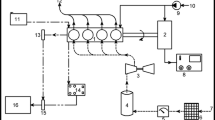Abstract
The cetane number is an indicator of ignition quality and thus of fuel quality in the realm of diesel engines. It is conceptually similar to the octane number used for gasoline. Generally, a compound that has a high octane number tends to have a low cetane number and vice versa. The cetane number of a diesel fuel is related to the ignition delay time. In our work the first approach is a statistical one the accuracy of which depends upon the data obtained from various papers and literature sources, as all equations used were based on this data. During prediction using more than one equation is a good approach, as it provides the accuracy as well as the relative error. The second approach is also a statistical one, but its value depends upon the saponification number and iodine value. Therefore the accuracy of this equation may be higher, since we can collect the data for saponification numbers and iodine values from literature, without needing to calculate them. Using the saponification number and iodine value we can select an optimal biodiesel as generally a good biodiesel is selected using these three values. Thus the second approach allows us the freedom to select a biodiesel.
Similar content being viewed by others
Change history
21 June 2022
An Erratum to this paper has been published: https://doi.org/10.1007/s12239-022-0104-0
References
Aldrich Catalog (1988). Aldrich Chemical Co. Milwaukee, WI.
Aldrich Catalog (1989). Aldrich Chemical Co. Milwaukee, WI.
ASTM Standard D1983-90 (1995). Standard Test Method for Fatty Acid Composition by Gas-Liquid Chromatography of Methyl Esters. ASTM. West Conshohocken PA.
Biodiesel Standard (1994). DIN V51606, Germany.
Biodiesel Standard (1999). ASTMPS121, USA.
Biodiesel Standard (2002). ASTMD 6751, USA.
Biodiesel Standard (2003). EN 14214, European Standard Organization.
Da Silva Ramos, L. C., Tango, J. S., Savi, A. and Leal, N. R. (1984). Variability for oil and fatty acid composition in castorbean varieties. JAOCS61,12, 1841–1843.
Dunn, R. O. and Bagby, M. O. (1995). Low-Temperature properties of triglyceride-based diesel fuels: Transesterified methyl esters and petroleum middle distillate/ester blends. J. Am. Oil Chem. Soc., 72, 895–904.
Freedman, B., Bagby, M. O., Callahan, T. J. and Ryan III, T. W. (1990). Cetane numbers of fatty esters, fatty alcohols and triglycerides determined in a constant volume combustion bomb. SAE Paper No. 900343.
Harrington, K. J. (1986). Chemical and physical properties of vegetable oil esters and their effect in diesel fuel performance. Biomass, 9, 1–17.
Kalayasiri, P., Jayashke, N. and Krisnangkura, K. (1996). Survey of seed oils for use as diesel fuels. J. American Oil Chemical Society, 73, 471–474.
Katwal, R. P. S. and Soni, P. L. (2003). Biofuels: An opportunity for socioeconomic development and cleaner environment. Indian Forester ISSN 0019-4816. Source/Source. 129,8, 939–949.
Kharasch, M. S. (1929). J. Res. Natl. Bur. Stand. (U.S.) 2:359.
Klopfenstein, W. E. (1985). Effect of molecular weights of fatty acid esters on cetane numbers as diesel fuels. J. American Oil Chem. Soc.65,6, 1029–1031.
Knothe, G. and Dunn, R. O. (2001). Biofuels derived from vegetable oils and fats. Gunstone, F. D., Hamilton, R. J. editors. Oleochemical Manufacture and Applications, UK, Sheffield Academic Press, 106–163.
Knothe, G., Dunn, R. O., Shockley, M. W. and Bagby, M. O. (2000). Synthesis and characterization of some longchain diesters with branched or bulky moieties. J. American Oil Chem. Soc.77,8, 865–871.
Krisnangkura, K. (1986). A simple method for estimation of cetane index of vegetable oil ethyl esters. J. American Oil Chem. Soc., 63, 552–553.
Ma, F. and Hanna, M. A. (1999). Biodiesel production: A review. Bioresour Technology, 70, 1–15.
Martini, N. and Shell, J. S. editors. (1998). Plant Oils as Fuels-Present State of Science and Future Development. Springer. Berlin. 276.
Mohibbe, M., Azam, A. W. and Nahar, N. M. (2005). Prospects and potential of fatty acid methyl esters of some non-traditional seed oils for use as biodiesel in India. Biomass and Bioenergy29, 293–302.
Ryan III, T. W. and Stapper, B. (1987). Diesel fuel ignition quality as determined in a constant volume combustion bomb. SAE Paper No. 870586.
Shafer, A. (1994). Biodiesel Research. Mercedes Benz-Engine Warrenty Policy, Presented at Commercialization of Biodiesel: Established of Engine Warranties. University of Idaho National Center for Advanced Transportation Technology. 125.
Swern, D. (1979). Bailey’s Industrial Oil and Fat Products, 1, 4th edn., John Wiley & Sons. New York. 159–177.
Tyagi, P. D. and Kakkar, K. K. (1991). Non-Conventional Vegetable Oils. Batra Book Service. New Delhi. India.
Author information
Authors and Affiliations
Corresponding author
About this article
Cite this article
Bose, P.K. RETRACTED ARTICLE: Empirical approach for predicting the cetane number of biodiesel. Int.J Automot. Technol. 10, 421–429 (2009). https://doi.org/10.1007/s12239-009-0048-7
Received:
Revised:
Published:
Issue Date:
DOI: https://doi.org/10.1007/s12239-009-0048-7




